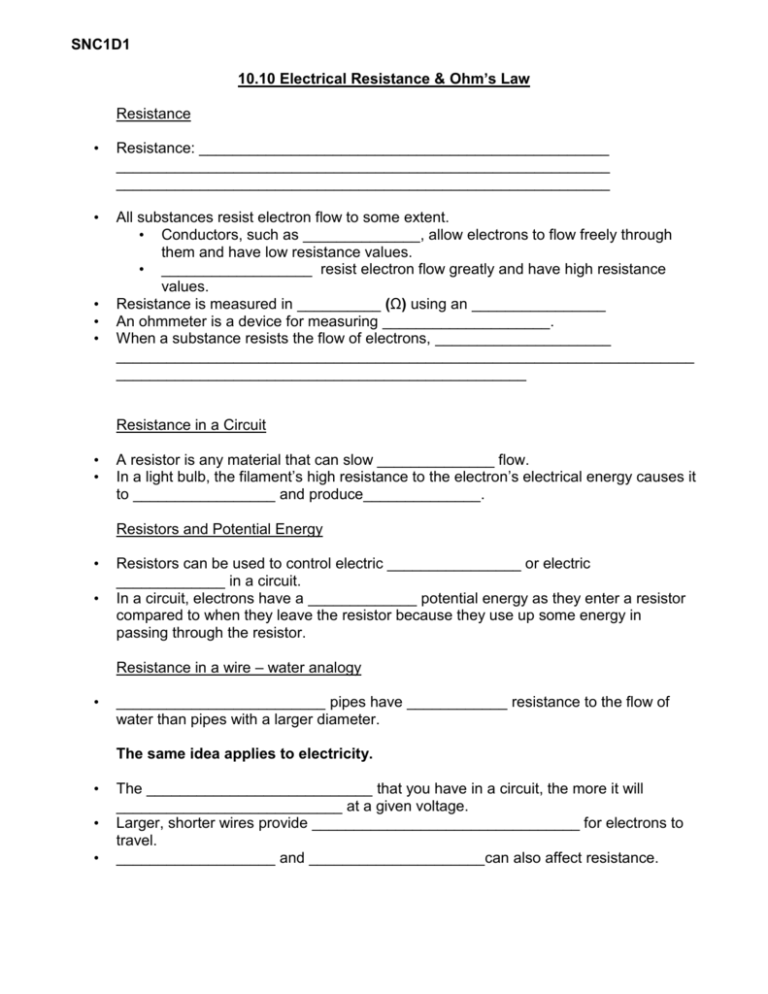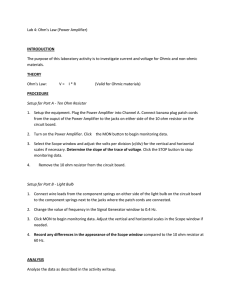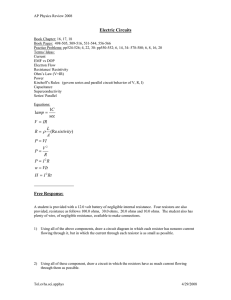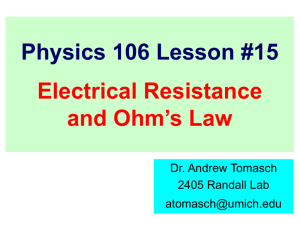SNC1D1 Electrical Resistance and Ohm's Law handout
advertisement

SNC1D1 10.10 Electrical Resistance & Ohm’s Law Resistance • Resistance: _________________________________________________ ___________________________________________________________ ___________________________________________________________ • All substances resist electron flow to some extent. • Conductors, such as ______________, allow electrons to flow freely through them and have low resistance values. • __________________ resist electron flow greatly and have high resistance values. Resistance is measured in __________ (Ω) using an ________________ An ohmmeter is a device for measuring ____________________. When a substance resists the flow of electrons, _____________________ _____________________________________________________________________ _________________________________________________ • • • Resistance in a Circuit • • A resistor is any material that can slow ______________ flow. In a light bulb, the filament’s high resistance to the electron’s electrical energy causes it to _________________ and produce______________. Resistors and Potential Energy • • Resistors can be used to control electric ________________ or electric _____________ in a circuit. In a circuit, electrons have a _____________ potential energy as they enter a resistor compared to when they leave the resistor because they use up some energy in passing through the resistor. Resistance in a wire – water analogy • _________________________ pipes have ____________ resistance to the flow of water than pipes with a larger diameter. The same idea applies to electricity. • • • The ___________________________ that you have in a circuit, the more it will ___________________________ at a given voltage. Larger, shorter wires provide ________________________________ for electrons to travel. ___________________ and _____________________can also affect resistance. Ohm`s Law • • • • • • Ohm’s law established the relationship between _______________ (V) and __________________ (I). Ohm`s law refers to the amount of resistance in a circuit. The symbol for resistance is called the _________ (Ω) in honour of Georg Ohm’s work in this field. According to Ohm`s law, the amount of voltage (or energy) in a circuit is equal to the current multiplied by the resistance. Ohm’s law states that, as long as temperature stays the same, ____________ if the resistance of a conductor remains constant, then the current is ______________________________________ to the voltage. Ohm`s Law and Temperature • • Ohm’s law works for most circuits. However, temperature _______________ resistance. Generally, resistance is _____________when a conductor is ______________. As the temperature increases, resistance increases. For example, a filament in an incandescent light bulb often has 10 times more resistance when the bulb is warm. Calculating Resistance • Resistance = voltage current Sample Problem #1: • A current of 4.0 A flows through a 40.0 Ω resistor in a circuit. What is the voltage? Use GRASP and sig. digits. Sample Problem #2: • A 30 V battery generates a current through a 15 Ω resistor. How much current does the battery generate? Use GRASP. Sample Problem #3: • An electric stove is connected to a 240-V outlet. If the current flowing through the stove is 22 A, what is the resistance of the heating element? Use GRASP and sig. digits.











